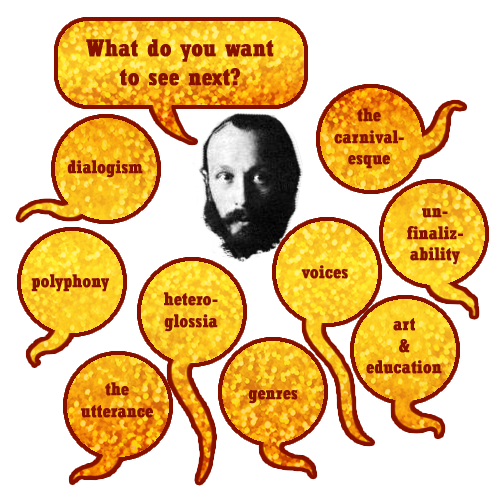

 | ||||
|
Utterances are discernible chunks of language-in-use. They may be as short as a single word (for example, "Damn!") or as long as a novel. Utterances may also be embedded within other utterances, which is indeed the case with much social discourse and many written texts...[U]tterances involve both the physical object produced - either spoken or written language - anda host of extralinguistic forces that helped to shape them. Those extralinguistic forces derive both from the social world and from the thinking processes of individuals. As such, utterances are both social and individual.
(Dimitriadis & Kamberelis, 2006, p.49) |
||||
 |
 |
 | |||
| The word in language is half someone else's. It becomes "one's own" only when the speaker populates it with his own intention. (Bakhtin, 1975/1981, p. 293) |
||||
 | ||||
 The word translated as "utterance" is "высказывание" (vi-skaz-i-van-i-ye). Its root is "сказ" (skaz), also the root of "сказка," or "folktale," giving a connotation of informal, immediate "folk" speech. Also, keep in mind that an oral tale even, if a prescriptive/traditional form, takes on a new life in each telling, and often becomes a new story when it is told by a different person.
The word translated as "utterance" is "высказывание" (vi-skaz-i-van-i-ye). Its root is "сказ" (skaz), also the root of "сказка," or "folktale," giving a connotation of informal, immediate "folk" speech. Also, keep in mind that an oral tale even, if a prescriptive/traditional form, takes on a new life in each telling, and often becomes a new story when it is told by a different person.
|
||||
 |
 |
 | |||
| The processes of centralization and decentralization, of unification
and disunification, intersect in the utterance; the utterance
not only answers the requirements of its own language as an individualized
embodiment of a speech act, but it answers the requirements
of heteroglossia as well; it is in fact an active participant
in such speech diversity. And this active participation of
every utterance in living heteroglossia determines the linguistic
profile and style of the utterance to no less a degree than its inclusion
in any normative-centralizing system of a unitary language.
Every utterance participates in the "unitary language" (in its
centripetal forces and tendencies) and at the same time partakes
of social and historical heteroglossia (the centrifugal, stratifying
forces). Such is the fleeting language of a day, of an epoch, a social group, a genre, a school and so forth. It is possible to give a concrete and detailed analysis of any utterance, once having exposed it as a contradiction-ridden, tension-filled unity of two embattled tendencies in the life of language. The authentic environment of an utterance, the environment in which it lives and takes shape, is dialogized heteroglossia, anonymous and social as language, but simultaneously concrete, filled with specific content and accented as an individual utterance. (Bakhtin, 1975/1981, p. 272) |
||||
 | ||||
|
So every utterance is a part of an existing language, but also the creation of language. By the same token, while every utterance (every quoted passage, every clicheed phrase, or simply every word we use) is a repetition of a prior utterance it is still imbued with unique meaning. That's very post-modern for a pre-WWII Soviet dude! ("Discourse in the Novel" was written in 1934-35, but not published in Russia until 1975). So, basically, we pile utterances on top of utterances on top of utterances to make meaning. Kind of like legos, or magnet poetry: Flash Magnetic poetry from The CBC. |
||||
 |

Ayers, W., & Alexander-Tanner, R. (2010). To teach: The journey, in comics. New York, NY: Teachers College Press.
Bakhtin, M. M. (1981). Discourse in the novel (C. Emerson & M. Holquist, Trans.). In M. Holquist (Ed.), The dialogic imagination: Four essays by Mikhail Bakhtin (pp. 259-422). Austin, TX: University of Texas Press. (Original work published 1975).
Bakhtin, M. M. (1981). Epic and Novel (C. Emerson & M. Holquist, Trans.). In M. Holquist (Ed.), The dialogic imagination: Four essays by Mikhail Bakhtin (pp. 3-40). Austin, TX: University of Texas Press. (Original work published 1941).
Bakhtin, M. M. (1981). Forms of time and of the chronotope in the novel (C. Emerson & M. Holquist, Trans.). In M. Holquist (Ed.), The dialogic imagination: Four essays by Mikhail Bakhtin (pp. 84-258). Austin, TX: University of Texas Press. (Original work published 1937).
Bakhtin, M. M. (1984). From Rabelais and his world (H. lswolsky, Trans.). In P. Morris (Ed.), The Bakhtin reader (pp. 195-244). New York, NY: Oxford University Press. (Original work published 1965).
Bakhtin, M. M. (1984). Problems of dostoevsky's poetics. (C. Emerson, Trans.). Minneapolis, MN: University of Minnesota Press. (Original work published in 1963).
Bakhtin, M. M. (1986). From speech genres and other late essays (H. lswolsky, Trans.). In P. Morris (Ed.), The Bakhtin reader (pp. 81-87). New York, NY: Oxford University Press. (Original work published 1976).
Cuenca, A. (2010). Democratic means for democratic ends: The possibilities of Bakhtin's dialogic pedagogy for social studies. The Social Studies, 102(1), 42-48.
Dimitriadis, G., & Kamberelis, G. (2006). Theory for education. New York, NY: Routledge.
Miles, A. P. (2010). Dialogic encounters as art education. Studies in art education: A journal of issues and research 51(4), 375-379.
Roberts, G. (1994). A glossary of key terms. In P. Morris (Ed.), The Bakhtin reader (pp. 245-252). New York, NY: Oxford University Press.
Rule, P. (2011). Bakhtin and Freire: Dialogue, dialectic and boundary learning. Educational philosophy and theory 43(9), 924-942.